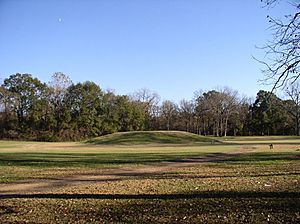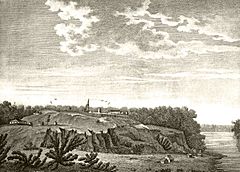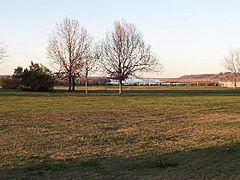Natchez revolt facts for kids
The Natchez revolt, also known as the Natchez massacre, was a big attack. It happened on November 29, 1729. The Natchez Native American people attacked French colonists. This took place near what is now Natchez, Mississippi.
Before this event, the Natchez and French had lived together. They were in the Louisiana colony for over ten years. They often traded peacefully and sometimes even married each other. But their relationship got worse. Natchez leaders were upset when a French leader, Sieur de Chépart, demanded their land. He wanted it for his own farm near Fort Rosalie.
The Natchez planned their attack for several days. They kept their plans secret from most French people. Some colonists heard warnings and told Chépart. But he didn't believe them and punished them. In a planned attack, the Natchez killed almost all the Frenchmen. They mostly spared the women and enslaved Africans. About 230 colonists died. The fort and homes were burned down.
When the French in New Orleans heard the news, they were scared. They feared a big uprising by Native Americans. They worried the Natchez had teamed up with other tribes. First, they ordered an attack on the Chaouacha people. The Chaouacha had nothing to do with the revolt. Their whole village was wiped out.
Then, the French and their Choctaw allies fought back against the Natchez. They captured hundreds of Natchez people. Many were sold into slavery. However, many Natchez escaped north. They found safety among the Chickasaw people. The Natchez kept fighting the French in small ways for years. But French attacks on Natchez refugees among the Chickasaw in 1730 and 1731 forced them to move. They lived as refugees among the Creek and Cherokee tribes.
By 1741, the Natchez had built a town. It was in the northern part of the Upper Creek Nation. With permission from the Abihka, they rebuilt their community. They signed important agreements like the 1790 Treaty of New York. They also signed the 1796 Treaty of Colerain. Today, the Natchez are still a part of the Muscogee (Creek) Nation.
The attack on Fort Rosalie hurt the Louisiana colony a lot. It destroyed many productive farms. It also made it dangerous to ship food and goods on the Mississippi River. Because of this, the French government took back control of Louisiana. This happened in 1731. Before, the Company of the Indies had been in charge. But they had trouble running the colony. Louisiana governor Étienne Perier was blamed for the attack. He was called back to France in 1732.
Contents
Why the Natchez and French Fought

In 1682, Robert de La Salle traveled down the Mississippi River. He was the first Frenchman to meet the Natchez. He said they were allies. The Natchez lived in nine separate villages. They were settled farmers. The French thought they were the most advanced tribe in the area.
By 1700, the Natchez population had shrunk. Diseases brought by Europeans caused this. Their numbers fell to about 3,500. By 1720, more diseases cut that number in half. Natchez society had strict groups. There were "the Suns," who were nobles. There were also "the Stinkards," who were common people.
Between 1699 and 1702, the Natchez welcomed explorer Pierre Le Moyne d'Iberville. They let a French missionary live among them. At this time, the Natchez were fighting the Chickasaw people. The Chickasaw had guns from their British allies. The Natchez hoped to get similar help from the French.
However, the British were also in the area. This caused the Natchez to split. Some favored the British, others the French. The main village, called Natchez or the Grand Village, had important leaders. These included the chief Great Sun and the war chief Tattooed Serpent. Both wanted an alliance with the French.
Early Conflicts: Natchez Wars
The first fight between the French and Natchez happened in 1716. The governor of Louisiana, Antoine Laumet de La Mothe, passed through Natchez land. He forgot to renew their friendship by smoking the peace calumet. The Natchez reacted by killing four French traders.
Cadillac sent his officer Jean-Baptiste Le Moyne de Bienville to punish them. Bienville tricked the Natchez leaders. He invited them to a meeting, then captured them. He forced the Natchez to trade their leaders for the people who attacked the French. Some random Natchez from pro-British villages were killed. This made relations much worse. After this First Natchez War, the Natchez had to help build a French fort.
By 1717, French colonists built Fort Rosalie. They also set up a trading post in what is now Natchez, Mississippi. They wanted to protect their trade in the area from the British. The French also got land for big tobacco farms. They also had smaller farms on land taken from the Natchez.
Relations between the Natchez and colonists were usually friendly. Some Frenchmen even married Natchez women and had children. But there were problems. Some colonists treated the Natchez badly. They forced them to work or give goods. As more colonists arrived, their farms took over more Natchez land.
From 1722 to 1724, there were short fights. Louisiana governor Bienville and Natchez war chief Tattooed Serpent settled them. In 1723, Bienville heard some Natchez had bothered villagers. He destroyed the Natchez village of White Apple. He enslaved some villagers. Later, he found out the colonists had lied to blame the Natchez.
One fight in 1724 involved a colonist killing a Natchez chief's son. The Natchez responded by killing a Frenchman. Bienville then sent French soldiers to attack the Natchez. The Natchez gave up. They asked for peace. This was granted after the French executed one of their chiefs.
A writer named Le Page du Pratz lived among the Natchez. He was a good friend of Tattooed Serpent. He once asked his friend why the Natchez disliked the French. Tattooed Serpent said the French seemed to have "two hearts, a good one today, and tomorrow a bad one." He explained that Natchez life was better before the French came. He ended by saying, "Before the arrival of the French we lived like men who can be satisfied with what they have, whereas today we live like slaves, who are not suffered to do as they please." Tattooed Serpent, a strong French ally, died in 1725. This was another blow to relations.
New Leadership, New Problems
In August 1726, a new governor arrived. His name was Étienne Perier. His arrival caused new problems. Perier changed Bienville's way of dealing with tribes. He refused to accept that Native Americans owned their traditional lands.
To oversee Fort Rosalie and the Natchez area, Perier chose Sieur de Chépart. People described Chépart as "greedy, proud, and mean." He treated soldiers, settlers, and the Natchez badly. Perier and Chépart worked together. They planned to build a big farm on Natchez land.
An archaeologist named Karl Lorenz studied Natchez settlements. He believes another problem was that the French didn't understand Natchez politics. The French thought the Great Sun, chief of the Grand Village, ruled all Natchez villages. But each village was somewhat independent. The Great Sun's power only reached the villages of Flour and Tioux. It did not include the three pro-British villages: White Apple, Jenzenaque, and Grigra. When the Great Sun died in 1728, his nephew took over. The nephew was not experienced. This made the pro-British villages stronger than the pro-French ones.
Commandant Chépart's Demands
In 1728, Chépart, the leader of Fort Rosalie, was put on trial. He was accused of misusing his power. But powerful friends helped him. Governor Perier pardoned Chépart. He sent him back to his command. Chépart returned to Fort Rosalie. He continued to treat the Native Americans badly.
Chépart wanted to help his and Perier's business plans. In spring 1729, he told the Natchez he wanted their land. He wanted it for a farm in the middle of White Apple. This was where the Natchez had a temple with their ancestors' graves. He put a missionary cross on the land. This showed he was acting on Perier's orders.
Most colonists did not approve of Chépart's actions. A French historian, Jean-François-Benjamin Dumont de Montigny, wrote about it. He said this was the first time a French leader just claimed Natchez land. There was no talk or agreement beforehand.
The Natchez protested taking their land. Chépart threatened to burn down their temple. It held their ancestors' graves. The Natchez seemed to agree to give up the land. But they asked for time until after the harvest. They needed to move their temple and graves. Chépart agreed to give them time. In return, he demanded animal skins, oil, poultry, and grain. The Natchez promised to give these later.
The Attack on Fort Rosalie

After Chépart told the Natchez they had to leave their land soon, they prepared. They planned to attack the French at Fort Rosalie. They borrowed guns from some French colonists. They promised to go hunting and share the game.
Some French men and women heard the Natchez planning the attack. According to Le Page du Pratz, a Natchez female chief tried to warn the French. She was called Tattooed Arm. She wanted to warn them about an attack by her rivals. When colonists told Chépart, he ignored them. He even put some in chains the night before the attack.
On the morning of November 29, 1729, the Natchez came to Chépart. They brought corn, poultry, and deerskins. They also carried a calumet, a symbol of peace. Chépart was sure the Natchez had no bad intentions. He challenged those who had warned him to prove their rumors were true.
While Chépart was taking the goods, the Natchez started firing. This was the signal for a planned attack. They attacked Fort Rosalie and the farms nearby. Chépart ran to call his soldiers. But they had already been killed. The details of the attack are not fully known. Writers like Le Page du Pratz said the events were "simply too horrific" to describe.
The Natchez had prepared well. They took control of a French ship on the river. This stopped any Frenchmen from escaping by boat. They also placed warriors on the other side of the river. These warriors would stop anyone who tried to flee that way. The leader at the Yazoo trading post, Monsieur du Codère, was visiting Fort Rosalie. He was with a Jesuit priest. They heard gunshots. They turned to go back to their ship. But warriors caught them and killed them.
The Natchez killed almost all 150 Frenchmen at Fort Rosalie. Only about 20 managed to escape. Some fled to New Orleans. Most of the dead were not armed. Women, children, and enslaved Africans were mostly spared. Many were locked in a house on the bluff. Several warriors guarded them. From there, they could see what was happening.
According to Dumont de Montigny, women who defended their husbands were captured or killed. A year after the event, the count of the dead was 138 men, 35 women, and 56 children. This was about 230 people in total. Some experts believe the Natchez spared the enslaved Africans. This was because they felt a connection with them. Some enslaved people even joined the Natchez. Others used the chance to escape to freedom.
A group of Yazoo people were with Commandant du Codère. They stayed neutral during the fight. But they were inspired by the Natchez revolt. When they returned to their fort, they destroyed it. They killed the Jesuit priest and 17 French soldiers.
The Natchez lost only about 12 warriors. Eight warriors died attacking the La Loire des Ursins family's home. The men there had been able to defend themselves.
Chépart himself was captured by the Natchez. At first, they didn't know what to do with him. Finally, they decided a "stinkard" should kill him. This was a member of the lowest group in the tribe. The Natchez kept two Frenchmen alive. One was a carter named Mayeux. He had to carry all the French goods to the Great Village. The other was a tailor named Le Beau. The Natchez hired him to make the colonists' clothes fit new owners. They set fire to the fort, the store, and all the homes. They burned them to the ground.



